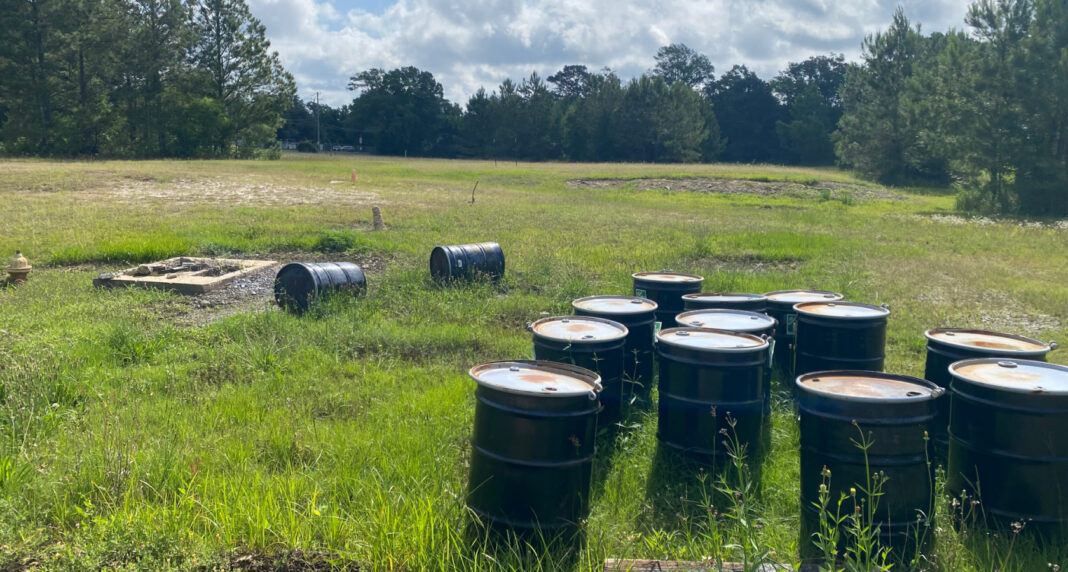Urgency to act on toxic property is not about health. It’s about ‘sealing’ the deal — and the toxins.
OCEAN SPRINGS, MS — The City of Ocean Springs is in a race against the clock when it comes to the toxic Leica property located on Pine Drive. But this race isn’t about saving lives or preventing illness — it’s a race to get the property sold and a slab poured. Because once that happens, everyone involved is shielded from liability.
At the heart of the issue is a former industrial site owned by Leica Microsystems, a multibillion-dollar corporation. The property is known to contain dangerous pollutants, including trichloroethylene (TCE), a carcinogen linked to neurological disorders and childhood cancers. But instead of demanding a full cleanup, city leaders are facilitating a transaction that could permanently bury the contamination — both physically and legally.
Time is of the essence, because on July 1, a new mayor and Board of Aldermen take office. And with them comes a mindset less likely to pour concrete over a toxic mess.
Leica’s Exit Strategy
Right now, Leica owns the toxic property, and with that ownership comes legal accountability. They’d very much like to pass both on to someone else.
Ocean Springs officials are backing a potential sale to Alabama developer Anand Patel, who plans to build a 108-room hotel and convention center on the land. If the sale goes through and a concrete slab — known as a vapor barrier — is poured, liability shifts. Patel, under an agreement with the Mississippi Department of Environmental Quality (MDEQ), could be granted immunity from future legal claims, and Leica could be legally insulated from further responsibility for good.
A ‘Clean’ Getaway
City officials have repeatedly assured the public that the toxic site on Pine Drive will be “clean” before construction begins on the new hotel. It’s a comforting word. It suggests safety, health, and resolution. But in the world of environmental law, “clean” doesn’t always mean what you think it means.
In fact, on contaminated sites like the Leica property, “clean” often means something very different: not safe, not toxin-free — just legally buildable.
Under Mississippi’s Brownfield Program, a site can be called “clean” or “remediated” even when toxic chemicals like TCE remain in the ground. Developers are not required to remove these toxins. They only need to:
- Pour a concrete slab (referred to as a vapor barrier) to block gas from seeping indoors
- Restrict overnight occupancy on the ground floor
- Agree to occasional testing and monitoring
That’s it. No excavation. No groundwater treatment. No elimination of the cancer-causing chemicals still beneath the surface.
This approach doesn’t stop the contamination. It simply buries it.
Once the slab is poured and construction begins, removing the cancer-causing chemicals will become nearly impossible. However, if the minimum standards are met, the developer will be shielded from being sued by the state for any possible liabilities. While civil suits resulting from illness could still occur, courts look favorably on developers who meet the minimum standards of the state.
In other words, if a loved one dies of cancer caused by the toxins at that site, there may be nobody to hold accountable.
What Happens Once the Slab Is Poured
In addition to the property owners being legally shielded, once the slab is poured and the hotel is built, any hope of future cleanup is effectively gone.
- Excavating the soil would require demolishing the hotel.
- Treating the plume beneath the structure becomes technically and financially prohibitive.
- The contamination, which is actively migrating, remains indefinitely.
Testing has not been done in over three years, and no updated health risk assessments have been shared with the public.
Yet the mayor and the city continue to claim the site will be “clean.”
A Simple Question the Mayor Won’t Answer
In an effort to clarify what city officials mean when they use the word “clean,” GC Wire posed the following questions to Mayor Kenny Holloway:
- When you state that the site will be “clean,” do you mean that all environmental contaminants (such as TCE) will be fully removed from the soil and groundwater?
- Or do you mean the site will meet the minimum standards set by the Mississippi Department of Environmental Quality (MDEQ) to allow construction under a brownfield agreement — such as the use of a vapor barrier, restrictions on ground-floor occupancy, and periodic monitoring?
Mayor Holloway never responded.
Confidential Cleanup
Last week, a spokesperson for developer Anand Patel told Ocean Springs officials the deal to purchase the property from Leica has been agreed on and he hopes for closing to occur before June 1.
Donovan Scruggs, who represents Patel, told the city that “some responsibilities” for the site’s contamination were being shuffled — though the details of who’s actually responsible for environmental remediation remained a mystery. When Mayor Kenny Holloway asked directly who would handle cleanup responsibilities, Scruggs responded plainly: “That’s confidential.” There was no further pushback from Holloway to get an answer.
Last year, Patel told the media he will be “100 percent responsible” for the cleanup of the toxic waste property and in a letter to the city, he said will exceed MDEQ standards. However, he offered no explanations of what that meant.
But court records from Alabama show that Anand Patel has faced multiple lawsuits tied to the maintenance of hotel properties, including a Ramada Inn and Days Inn in Brewton, as well as a Quality Inn in Atmore.
Mayor Holloway brushed off concerns. “The city isn’t really out anything with this guy if he doesn’t do what he says he’s going to do,” he recently told the press, referring to the millions of dollars in taxpayer money the city has promised to reimburse Patel after completion of the project.
Legal Strategy Masquerading as a Safety Plan
The mayor’s statements indicate he is more concerned about financial worries, rather than health risks to the community. City Clerk Patty Gaston appears to share that same mindset.
When asked in a formal media inquiry what steps the city had taken to request new environmental testing or updated risk assessments from MDEQ, Gaston told GC Wire that the city had hired Butler Snow — a law firm.
When asked for clarification — specifically, whether this was a legal risk analysis or an actual scientific risk assessment — Gaston offered no answers. Instead, she replied with screenshots she said she “found on the internet.”
Those screenshots showed exactly what the firm specializes in: defending clients in lawsuits over contaminated land.
Holloway echoed the sentiment to city leaders last week, reassuring them, “We have a layer of protection through the environmental attorney.”
The City Could Stop the ‘Cover-Up’
Experts say true cleanup of the site – meaning removing the cancer causing toxins – would take 10 to 20 years or more. But that’s not what is going to happen.
According to the U.S. Environmental Protection Agency: “Cleanup does not necessarily mean removing all contaminants. Rather, it often involves containing contaminants to prevent exposure.”
That’s what’s happening here. Not a cleanup — a cover-up.
Literally.
The slab acts as a vapor barrier, but the toxic plume beneath remains, actively migrating and capable of spreading into nearby properties, homes, or public areas over time.
And it never gets removed.
This kind of remediation leaves a permanent hazard beneath the surface. But concrete cracks. Monitoring gets neglected. Ownership changes. Developers walk away.
And the contamination stays.
Yet despite these risks, the City of Ocean Springs has not passed a single ordinance prohibiting new construction on known contaminated sites. It has the authority to do so. The city could require:
- Full removal of contaminated soil or groundwater before development
- An independent, peer-reviewed health risk assessment
- Stronger public input before issuing construction permits on toxic properties
But Ocean Springs has chosen not to do any of these things. Instead, it’s pushing the deal forward — quickly — before a new administration takes office on July 1.
This isn’t just regulatory laziness. It’s a conscious decision to leave toxic waste in place forever, simply because the law allows it. And it’s being done with full knowledge that the plume could spread, public safety may be compromised, and no one will be held responsible.
Not a Cleanup. Just a Deadline.
Ocean Springs officials keep using the word “clean” — but their actions show they’re far more concerned with their own political deadlines than detoxification.
A billion-dollar company is walking away from its toxic waste. A developer with a track record of safety violations is promising to exceed the minimum. And a mayor who won’t define “clean” says the city has nothing to lose.
Meanwhile, the contamination remains — and the clock runs out.
This is not a cleanup. It’s a transaction dressed up as progress. And unless the city acts now, it may soon be a hotel and convention center built over a toxic time bomb.
The public is being asked to accept a definition of “clean” that still leaves cancer-causing chemicals in the soil, a toxic plume beneath their city, and no one left to sue if tragedy strikes.
It may satisfy lawyers and regulators. But it won’t protect the families who live nearby.
Once the concrete is poured, the contamination — and the accountability — will be buried for good.
A Call to Action: What You Can Do
If you believe the City of Ocean Springs shouldn’t rush to build a hotel over a known toxic plume — now is the time to speak up.
The next Board of Aldermen meeting is scheduled for Tuesday, May 20 at 6:00 p.m. at City Hall. During the meeting, there will be a public comments section, where any resident can take the microphone and make a brief statement. You don’t need to be an expert — just a concerned citizen.
Here are a few things you can say:
- Ask the city to pass an ordinance prohibiting large-scale construction on contaminated land until the toxins are actually removed — not just buried.
- Demand full public disclosure of any environmental risk assessments, cleanup plans, or monitoring agreements related to the Leica site.
- Urge city officials to stop using vague language like “clean” or “remediated” without clearly explaining what that means in practical and health terms.
- Insist that taxpayer incentives — like TIFs and GCRF grants — not be handed out until the contamination is truly addressed and the public is fully protected.
- Request independent environmental testing and long-term health monitoring for nearby areas that may already be affected by the migrating plume.
You don’t have to speak long or as an expert — just speak truthfully, say what you feel.
This deal is moving fast. The slab isn’t poured yet. And once it is, there’s no going back.
Your voice may be the only thing left standing between your community and a toxic mistake.



This site needs to be a FEDERAL hazardous clean up site. Pouring a slab of concrete over the entire area will fix nothing!!! Come on Ocean Springs DEMAND this site be cleaned up! As the article says above, the toxins are spreading and will continue to do so after any concrete is poured. Don’t listen to MDEQ, or your city administration they are not professionals in the are of toxic clean up. If you do nothing, it is you children and grandchildren who will suffer…..